 |
||
|
||
| ||
TABLE OF CONTENTS
Let's talk about the time. Yes, about the time that sometimes drags itself along, making you count days and hours, or flies like a rocket. Of course, it's all relative, it passes through the prism of human conscience and it even depends on an industry. What concerns me, a veteran (not in the direct sense of this word! :) ) of the IT industry, I remember well the computing machinery "Ural", huge cabinets stuffed with electronics, immense terminals... It seems so close... a couple of years ago maximum. But it was actually decades ago. To say nothing about the flight of time in 3D graphics. Andrey Kuzin from 3DNews will agree that it's as though he and his partner received the desired Voodoo2 only six months ago and held it in trembling sweating hands, not daring to believe their luck. But it actually happened seven years ago. In this space of time Konstantin Martynenko (aka Kenguru) has grown from a youth carried away by 3D graphics, who established the Reactor Critical web site and published articles with such sentences as "Look at this dude... Can you see the filtering?", into an experienced Sapphire Technology employee (we'll talk about this company a tad later :) ). I have a friend, who got addicted to NVIDIA products (it was the Riva128 and then the RivaTNT). Even now that this product line is long discontinued, he still feels nostalgic about "Riva-ism". Thus we can see that the time sometimes holds back its horses, though it generally tends to accelerate. Do you remember that NVIDIA and ATI silently agreed on launching new products each six months and designing totally new products once a year? While ATI manages to keep its promise this year, though it had treated us only with the overclocked R300 under different dressings for two years, NVIDIA is dead calm. A year passed since the NV40 announcement, and nothing new has come up after it. The launch of NV45 does not count, because it's the same NV40, but with a HSI bridge. It seems high time for NVIDIA to offer a cardinally new solution, but we'll wait and see what the G70 will be like. Perhaps the company shamefacedly hides the old technologies under the new codename (that is another overclocked mode or more pipelines). Though I said that the canadian company managed to keep its promise, and that there would be launched a new generation product soon (R520), and that a new stepping of the R420, called R480, had been launched prior to that, I should admit that all these releases look very pale. Just think about it: the company designed a new 0.13-micron chip with 16 pipelines, it's very intricate though it has only 160 million transistors versus 220 millions in NVIDIA NV40. It was not all plain sailing at first, the yield of effective chips was very low, so the X800 XT had been in deficit until the beginning of this year.
But then the situation with the R420 or the R423 normalized (it's the same R420, but with PCI-E instead of AGP). The processing technology was streamlined, the products were set up for mass production. But why kid around with customers giving a new name R480 (RADEON X850) to the same product and offering it as a new video card? Intel launched many steppings of the same processor, but they are all called Pentium4, instead of Pentium4-a, 4-b, etc. But ATI always gives new names to improved products and shouts about its innovations being the best in the world. But it hushes up that the X850XT equals the X800XT PE in frequency, thus it's THE SAME PRODUCT. It was decided impertinent though to give a new name to the same product and the memory frequency was slightly reduced. But our tests demonstrated IDENTITY of the cards. Indeed, the X800 XT PE and the X850 XT have different Device ID in BIOS, that's why the drivers may be configured so that the X800 XT will have no optimizations, its performance dropping, and the X850XT will have plenty of them, shooting forward. We have seen it with the R350 (RADEON 9800 PRO), which differed from the R300 (RADEON 9700 PRO) ONLY by the frequency. However, the drivers at that time were optimized so that the 9800 PRO was faster than the 9700 PRO at the time its sales started. Later on these optimizations were introduced for all cards, the delta dropped, but that didn't bother the Canadian company. It already skimmed the cream. The company designed a chip that easily runs at 540 MHz instead of 520 MHz (the difference is not that great!), so what? Why didn't it call the chip like X800 XT EE (Extreme Edition) and switch the production to a more profitable chip? Why on earth did they cut a dash and pretended that the X850 differed from the X800? Do you remember the old story with the RADEON 9200 and 9250, when the same chip with lower frequencies got a higher index? Is the arithmetic forgotten in Canada? It applies both to PCI-E solutions as well as to AGP solutions, because the R420/481 (R423/480) are like twins. I understand that the middle end R430 is manufactured by the 0.11-micron processing technology and it also needs a name. So where were marketing specialists, when cards were named X600, X700? Why AGP video cards are called 9600, while PCI-E video cards are X300? The overclocked versions of the same AGP products are named logically - 9600 PRO, XT. But for some unknown reason, their PCI-E counterparts are called X600 PRO, XT instead of X300 PRO, XT. These cards should have been called X300, the X700 series would become X500. And the new R430 would be called X700. There would be no need in confusing people with the X850, the product would retain the X800 name. And each series would have its SE/PRO/XT. Everything would be nice and logical. But no, it's too boring for marketing, it's not interesting, they need confusing people and make them buy THE SAME PRODUCT under a different name... Alas. Later on, I will get back to criticism. And now let's return to the subject of the article. So, we are going to examine five video cards: from the currently most powerful X850XT PE to the weakest in a huge series of DX9 cards - X300SE HM. HM stands for HyperMemory - a counterpart of TurboCache from NVIDIA, that is when a video card uses the system RAM as its own when necessary, taking advantage of the huge PCI-Express bandwidth. The new cards have some unique solutions among them, i.e. those cards that we are going to review for the first time: the RADEON X850 PRO (a counterpart of the previous X800 PRO, but running at higher frequencies and having the PCI-E interface) as well as the RADEON X800 AGP. The latter card is very interesting, because the AGP segment already suffers from a great deficit of accelerators at $280-$350 (only the GeForce 6800 scarcely manages to satisfy the demand, but ATI offers nothing in this sector). The five video cards under review include only three video cards manufactured by Sapphire: the X800 AGP, the X800 XL Ultimate, and the X300SE HM. The two remaining cards are manufactured by ATI's orders. Its partners just buy ready solutions. As ASUS or Gainward with Prolink, eVGA, BFG taken together are important to NVIDIA, Sapphire is the first ATI's partner, actually one of the largest nowadays, that manufactures products ONLY on processors from this canadian company. It has earned great authority for the years on the Russian market, so there is no need in describing this Hong Kong manufacturer. We should proceed to video cards.
Video Cards
Even a single look is enough to understand that Sapphire doesn't deviate from the reference-designs, all the cards comply with the layout recommended by ATI (which is a good thing considering the PCB complexity). And those cards that are not manufactured by Sapphire are all the more reference copies (hint: if you see a sicker on the back of a card running P/N 102A....., it means that this card is made by ATI order, it's not manufactured by a partner on its own). Only the X300SE HM has some peculiarities. It's clear that the card differs from the X300SE by only two memory chips (instead of four) in BGA-package instead of TSOP. Nevertheless, the reference X300SE HM has only one DVI connector, while the product from Sapphire has two (it's an advantage of the card from Sapphire).
Let's review the cooling systems.
Now I want to get back to how the coolers look. I've been asking myself one question for a long time: why do engineers always choose the most awkward in form, silliest looking, and even squalid reference cooling systems? Cooler manufacturers are in immense quantity! You can order any solution you like! But no! NVIDIA had been equipping its video cards with horrible militarist-looking coolers for many years (noisy ones at that):
To say nothing of FlowFX, a real laughing stock. By the way, the GF 5950 demonstrates a return to a quieter version of FlowFX. We all remember a piece of steel reinforcement stuffed under this cooler, pretending to be a memory heatsink. It was an atrocity! There seems to be no taste and probably even no designers! Even if it's a reference, the card not intended for sales. But NVIDIA and ATI are well aware that lots of their partners don't even get around to replace stickers on coolers, to say nothing of replacing cooling systems proper. In fact, I can list only 5-6 companies that try to improve this situation. The other ones don't care. The same applies to ATI. WHY ON EARTH did they replace a decently looking small cooler with a two-slot howling monster, which NOBODY NEEDS? - the frequency difference between the X800 XT PE and the X850XT PE is only 20 MHz (the X800 XT PE and the X850 XT offer equal frequencies!) Do the NVIDIA's laurels for monstrous coolers haunt their dreams? If a two-slot cooler is inevitable, why shouldn't you look around! Take HIS, for example! It was the first company to cooperate with Arctic Cooling, which cooling devices are famous for their efficient and noiseless operation. We cry out to ATI, of course. I would have never installed into my computer such a monstrosity as a reference cooler from the X850XT. Why should I listen to that howling, even if at startup only? I can always turn to HIS with its cooler, more efficient, more effective, as well as noiseless. I'm sure I can find other solutions from various manufacturers of cooling systems. Zalman, after all. But no, reference cards always suffer from either howling coolers, or ugly coolers, or inefficient ones. I don't know why. There are only several exceptions: for example, a cooler a la GeForce4 Ti. It looked nice, it was quiet, and it was efficient for its time. This solution is still employed by video card manufacturers in this form or another. Now what concerns advantages of cooling systems from Sapphire. It goes without saying that offering video cards with such a device already installed has its advantages, even considering that users may buy Zalman coolers on their own. Firstly, it's not that simple to install coolers even in factory conditions; secondly, many users will surely not venture to unscrew anything on a video card to replace a cooler. We have also seen that the cooling systems in X800/X800XL/X850PRO are very satisfactory in their efficiency and noise level, and they are not that large. It's good news, considering that the first X800XL cards from Sapphire had horrible cooling systems, bellowing like slaughtered monsters in games. Note that not a single video card from those we review today is equipped with two DVI connectors. All of them offer d-Sub and DVI. You can also see that some cards are equipped with RAGE Theater, thus they support VIVO.
Bundle
Packages.
Installation and DriversTestbed configurations:
VSync is disabled.
Now what concerns overclocking. Of course, such a cooler on the X800 XL Ultimate gives an opportunity to test its overclocking capacities and see what frequencies it can reach without additional cooling, using only the standard cooler from Zalman. We got the following results: 460/1147 MHz! Actually, it's a record among the X800 XL based video cards I have ever reviewed. The temperature conditions are also within the mark (I have deliberately set the rotational speed of the cooler to 100%, because it's noiseless anyway):
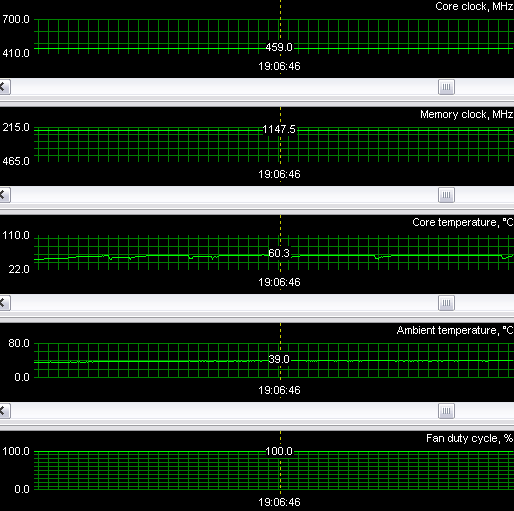
It would also be interesting to overclock the X850 PRO and see whether it can catch up with the X850 XT. Especially as the overclocked mode was very impressive: 590/1200 MHz. Temperature conditions are also within the mark.
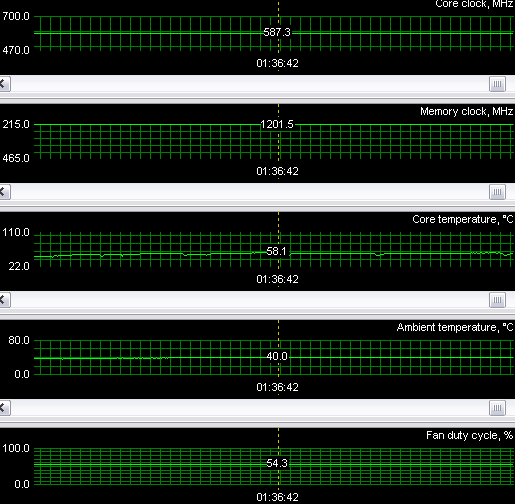
Test results: performance comparisonWe used the following test applications:
Game tests that heavily load pixel shaders 2.0.TR:AoD, Paris5_4 DEMO
RADEON X850 PRO/X800 AGP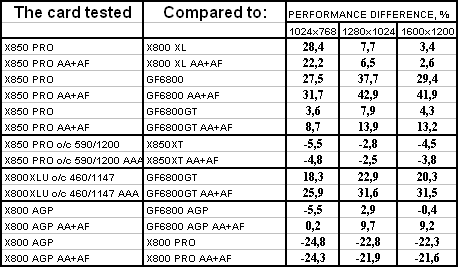 RADEON X300 SE HyperMemory
This test heavily loads Shaders 2.0, it mostly uses the calculating power of chips. That's why ATI solutions are traditionally good at it. However, it didn't help the X300SE HM, which lost the battle to the 6200TC. What concerns the X850 PRO, this card outperformed the X800 XL, but in the overclocked mode it even reached the X850 XT performance. The overclocked X800 XL Ultimate even caught up with the 6800GT. The X800 AGP demonstrated very good results versus the competing 6800. It expectedly lagged behind the X800 PRO. Game tests that heavily load vertex shaders, mixed pixel shaders 1.1 and 2.0, active multitexturing.FarCry, Research
RADEON X850 PRO/X800 AGP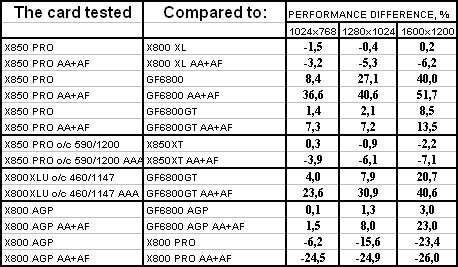 RADEON X300 SE HyperMemory
FarCry, Regulator
RADEON X850 PRO/X800 AGPTest results: FarCry Regulator
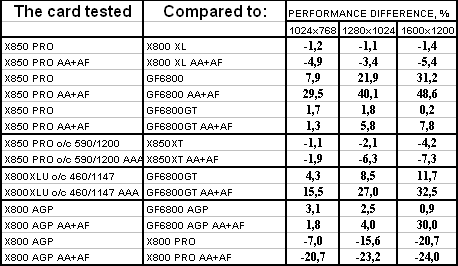 RADEON X300 SE HyperMemoryTest results: FarCry Regulator

FarCry, Pier
RADEON X850 PRO/X800 AGP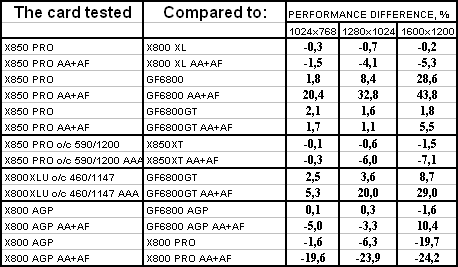 RADEON X300 SE HyperMemory Obviously, the X300SE HM does not hold up in the race here either. It's completely outperformed. It probably happens due to the lower memory operating frequency, or perhaps the TC algorithm in NVIDIA drivers is more effective than HM in the drivers from ATI.
The X850 PRO demonstrated results, which are nearly identical to those of the X800 XL (at a higher price!), it outperformed the competitors from NVIDIA, and in the overclocked mode it nearly reached the X850 XT level. The X800 AGP proved itself on a par with its competitor.
Game tests that heavily load both vertex shaders and pixel shaders 2.0Half-Life2: ixbt01 demo
RADEON X850 PRO/X800 AGPTest results: Half-Life2, ixbt01
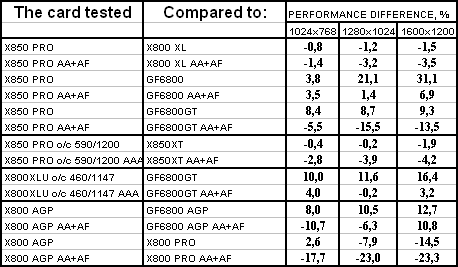 RADEON X300 SE HyperMemoryTest results: Half-Life2, ixbt01

Half-Life2: ixbt02 demo
RADEON X850 PRO/X800 AGPTest results: Half-Life2, ixbt02
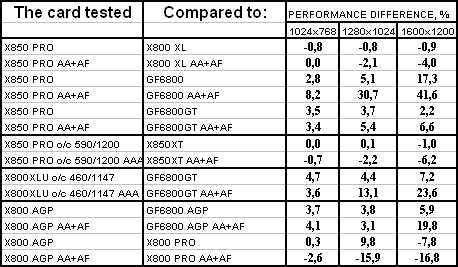 RADEON X300 SE HyperMemoryTest results: Half-Life2, ixbt02

Half-Life2: ixbt03 demo
RADEON X850 PRO/X800 AGPTest results: Half-Life2, ixbt03
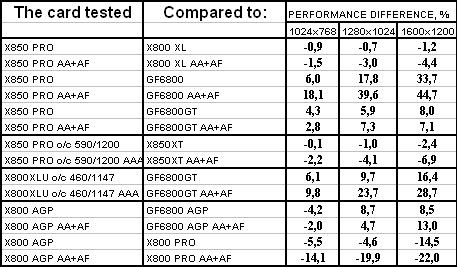 RADEON X300 SE HyperMemoryTest results: Half-Life2, ixbt03
 ATI driver optimizations for this game helped the X300SE HM to somehow grade up to its competitor, but still the victory is unattainable. The X850 PRO also demonstrated the performance similar to that of the X800 XL, it outperformed the competing 6800, and graded up to the 6800GT. But it didn't catch up with the X850 XT even in the overclocked mode (high as it is).
The X800 AGP fairs very good, being a worthy competitor. Game tests that heavily load pixel pipelines with texturing, active operations of the stencil buffer and shader unitsDOOM III
RADEON X850 PRO/X800 AGP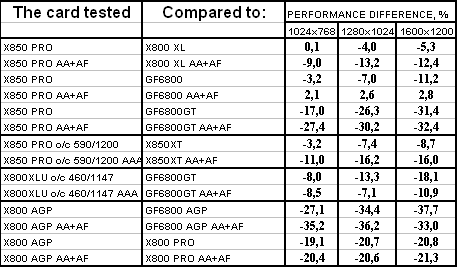 RADEON X300 SE HyperMemory
Chronicles of Riddick, demo 44
RADEON X850 PRO/X800 AGPTest results: Chronicles of Riddick, demo 44
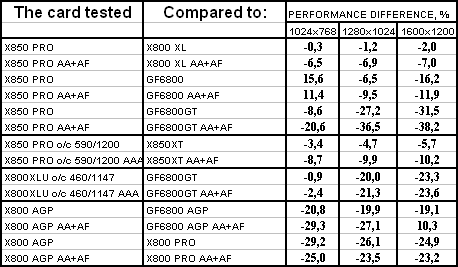 RADEON X300 SE HyperMemoryTest results: Chronicles of Riddick, demo 44

Chronicles of Riddick, demo ducche
RADEON X850 PRO/X800 AGPTest results: Chronicles of Riddick, demo ducche
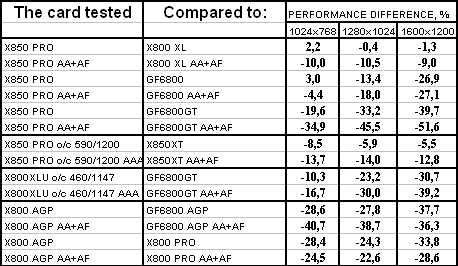 RADEON X300 SE HyperMemoryTest results: Chronicles of Riddick, demo ducche

It's all clear in this block of tests: NVIDIA's family won the battle, it's clear even without a thorough analysis.
Synthetic tests that heavily load shader units3DMark05: MARKS
RADEON X850 PRO/X800 AGP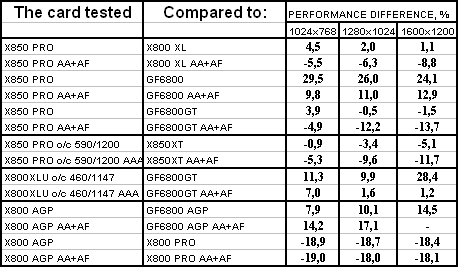 RADEON X300 SE HyperMemory I guess that the test description alone is enough to understand that the ATI family will have a head start here, except the X300SE HM.
RADEON X850XT PE
Summary performance diagrams
These tests clearly demonstrate that the X850 XT PE is an overall leader among the single-card accelerators (ignoring SLI). Disadvantages only in some OGL tests (DOOM III, CoR)
Conclusions
You can find more detailed comparisons of various video cards in our 3Didest.
According to the test results, the Sapphire RADEON X800 XL Ultimate PCI-E 256MB gets the Original Design award (May).

Theoretical materials and reviews of video cards, which concern functional properties of the GPU ATI RADEON X800 (R420)/X850 (R480)/X700 (RV410) and NVIDIA GeForce 6800 (NV40/45)/6600 (NV43)
Write a comment below. No registration needed!
|
Platform · Video · Multimedia · Mobile · Other || About us & Privacy policy · Twitter · Facebook Copyright © Byrds Research & Publishing, Ltd., 1997–2011. All rights reserved. | |||||||||||||||||||||||||||||||||||||||||||||||||||||||||||||||||||